MITSUBISHI L200 2012 Owner's Manual (in English)
Manufacturer: MITSUBISHI, Model Year: 2012, Model line: L200, Model: MITSUBISHI L200 2012Pages: 370, PDF Size: 23.14 MB
Page 261 of 370
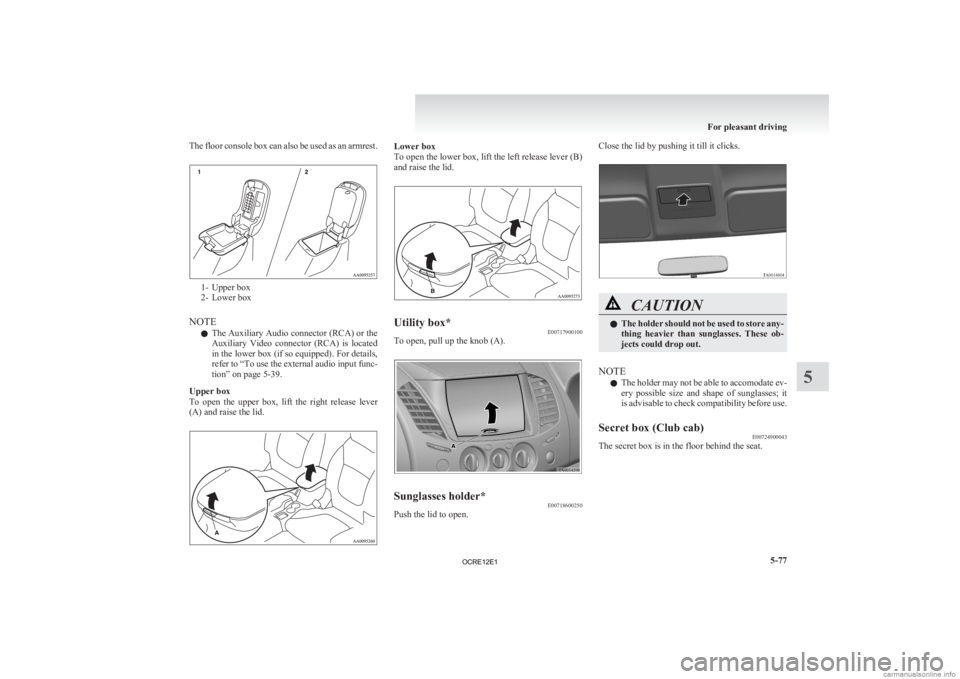
The floor console box can also be used as an armrest.
1- Upper box
2-
Lower box
NOTE l The Auxiliary Audio connector (RCA) or the
Auxiliary Video connector (RCA) is located
in the lower box (if so equipped). For details,
refer to “To use the external audio input func-
tion” on page 5-39.
Upper box
To open the upper box, lift the right release lever
(A) and raise the lid. Lower box
To
open the lower box, lift the left release lever (B)
and raise the lid. Utility box*
E00717900100
To open, pull up the knob (A). Sunglasses holder*
E00718600250
Push the lid to open. Close the lid by pushing it till it clicks.
CAUTION
l
The
holder should not be used to store any-
thing heavier than sunglasses. These ob-
jects could drop out.
NOTE l The
holder may not be able to accomodate ev-
ery possible size and shape of sunglasses; it
is advisable to check compatibility before use.
Secret box (Club cab) E00724900043
The secret box is in the floor behind the seat. For pleasant driving
5-77 5
OCRE12E1
Page 262 of 370
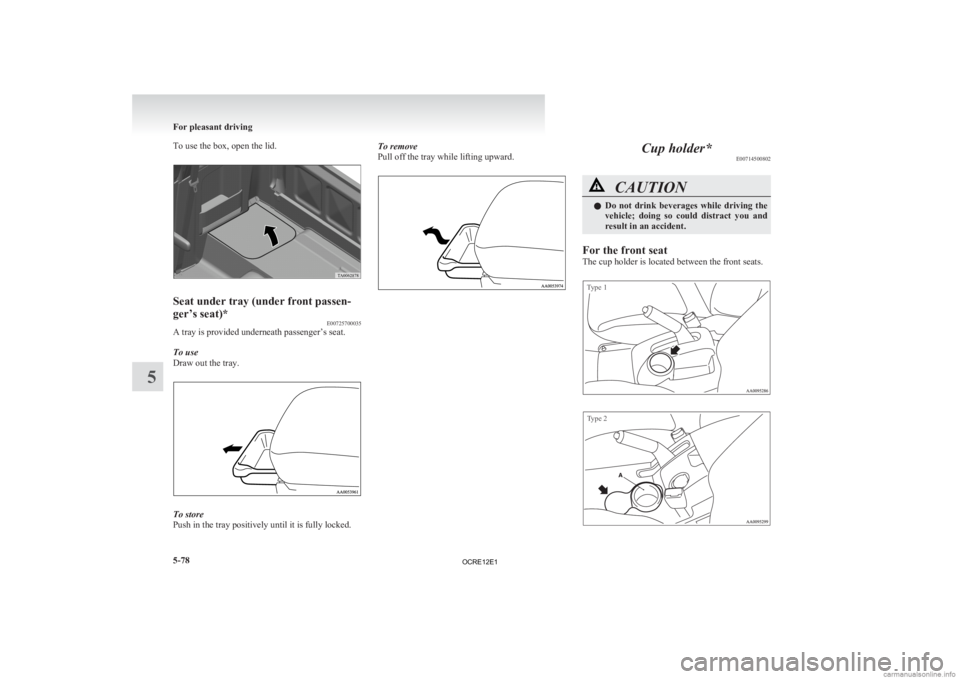
To use the box, open the lid.
Seat under tray (under front passen-
ger’s seat)*
E00725700035
A tray is provided underneath passenger’s seat.
To use
Draw out the tray. To store
Push in the tray positively until it is fully locked. To remove
Pull off the tray while lifting upward. Cup holder*
E00714500802 CAUTION
l
Do not drink beverages while driving the
vehicle; doing so could distract you and
result in an accident.
For the front seat
The cup holder is located between the front seats.
Type 1
Type 2 For pleasant driving
5-78
5
OCRE12E1
Page 263 of 370
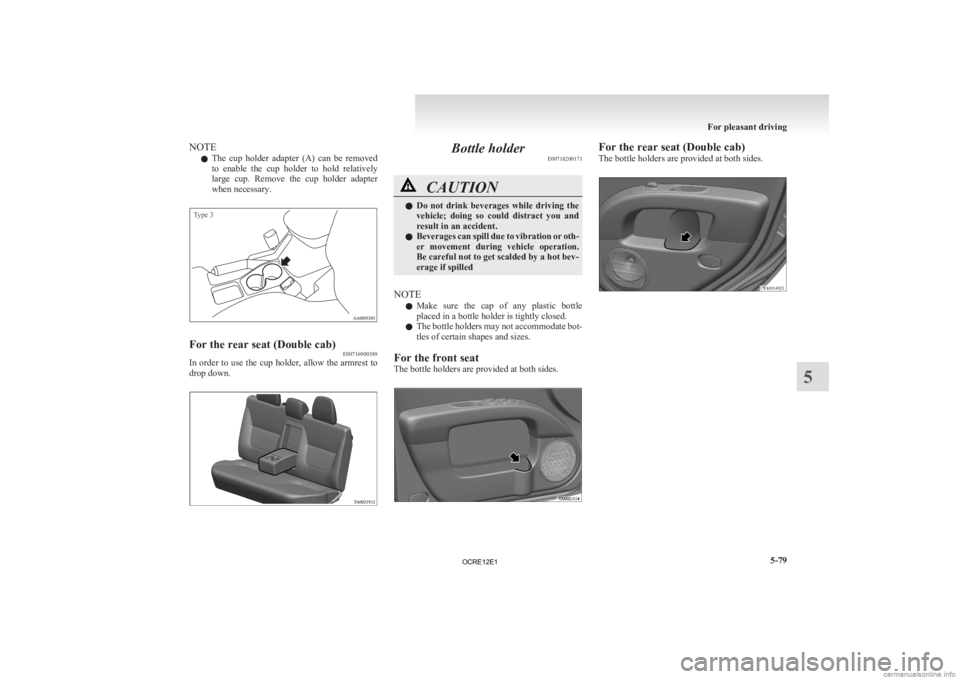
NOTE
l The
cup holder adapter (A) can be removed
to enable the cup holder to hold relatively
large cup. Remove the cup holder adapter
when necessary.
Type 3 For the rear seat (Double cab)
E00716900389
In order to use the cup holder, allow the armrest to
drop down. Bottle holder
E00718200171 CAUTION
l
Do not drink beverages while driving the
vehicle; doing so could distract you and
result in an accident.
l Beverages can spill due to vibration or oth-
er movement during vehicle operation.
Be careful not to get scalded by a hot bev-
erage if spilled
NOTE l Make
sure the cap of any plastic bottle
placed in a bottle holder is tightly closed.
l The bottle holders may not accommodate bot-
tles of certain shapes and sizes.
For the front seat
The bottle holders are provided at both sides. For the rear seat (Double cab)
The bottle holders are provided at both sides. For pleasant driving
5-79 5
OCRE12E1
Page 264 of 370
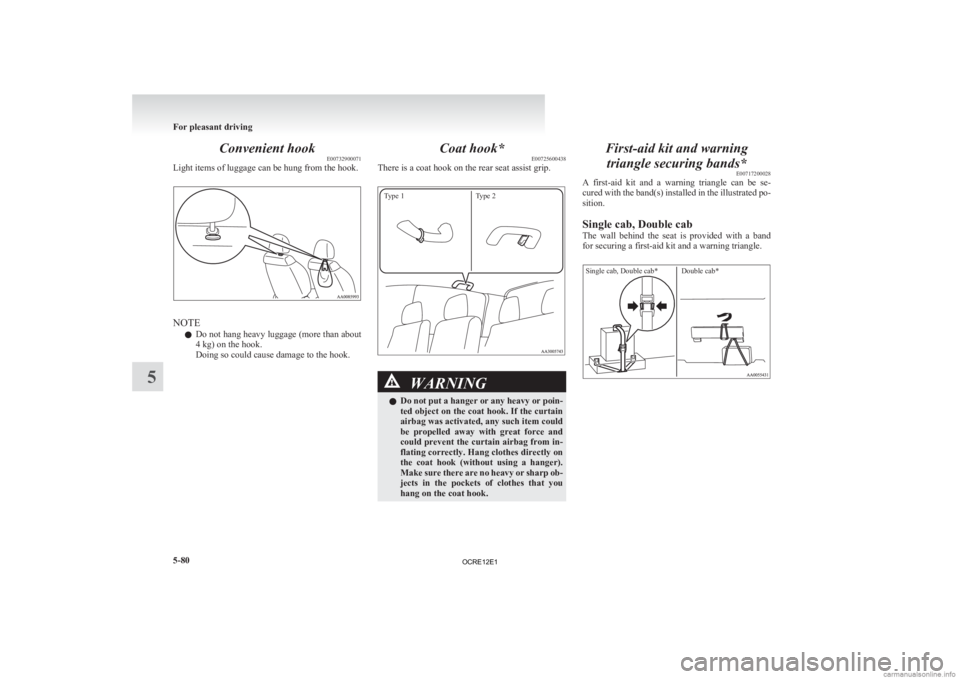
Convenient hook
E00732900071
Light items of luggage can be hung from the hook. NOTE
l Do
not hang heavy luggage (more than about
4 kg) on the hook.
Doing so could cause damage to the hook. Coat hook*
E00725600438
There is a coat hook on the rear seat assist grip.
Type 1 Type 2 WARNING
l Do
not put a hanger or any heavy or poin-
ted object on the coat hook. If the curtain
airbag was activated, any such item could
be propelled away with great force and
could prevent the curtain airbag from in-
flating correctly. Hang clothes directly on
the coat hook (without using a hanger).
Make sure there are no heavy or sharp ob-
jects in the pockets of clothes that you
hang on the coat hook. First-aid kit and warning
triangle securing bands* E00717200028
A
first-aid kit and a warning triangle can be se-
cured with the band(s) installed in the illustrated po-
sition.
Single cab, Double cab
The wall behind the seat is provided with a band
for securing a first-aid kit and a warning triangle.
Single cab, Double cab* Double cab* For pleasant driving
5-80
5
OCRE12E1
Page 265 of 370
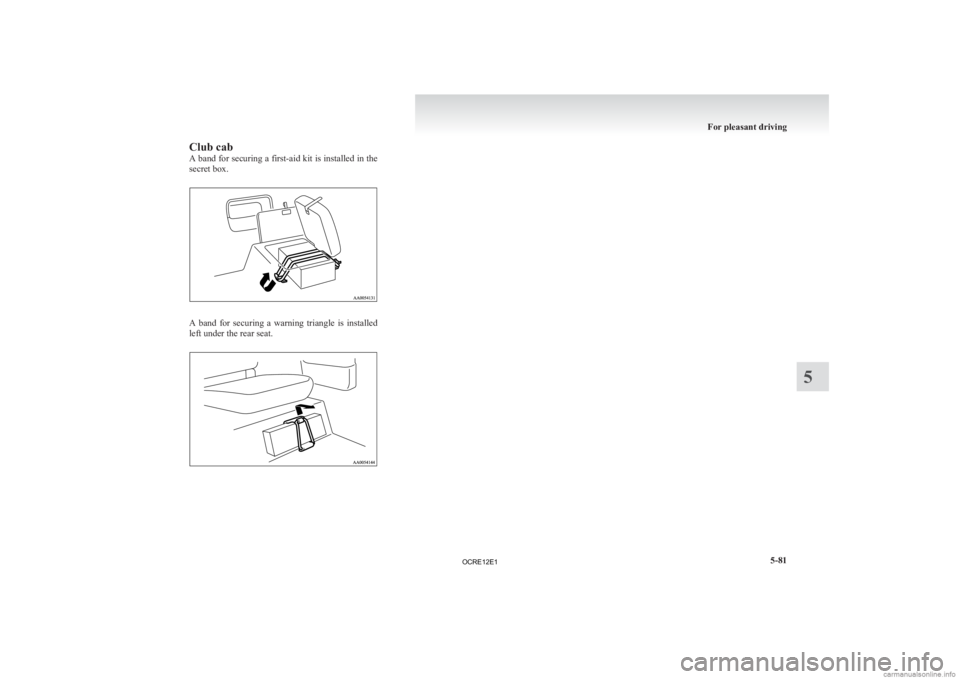
Club cab
A
band for securing a first-aid kit is installed in the
secret box. A band for securing a warning triangle is installed
left under the rear seat. For pleasant driving
5-81 5
OCRE12E1
Page 266 of 370
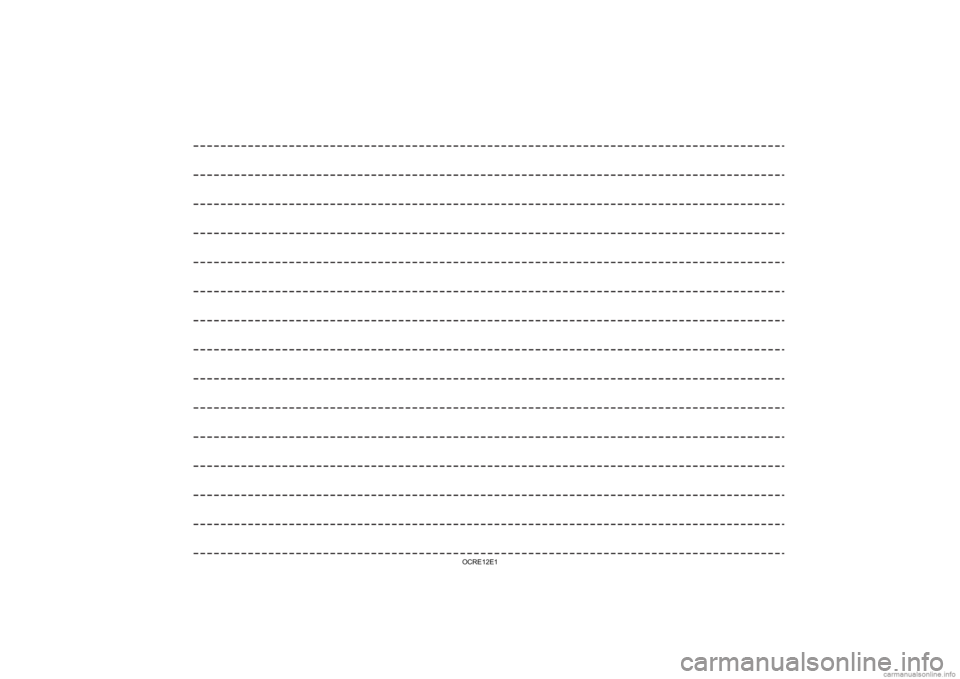
OCRE12E1
Page 267 of 370
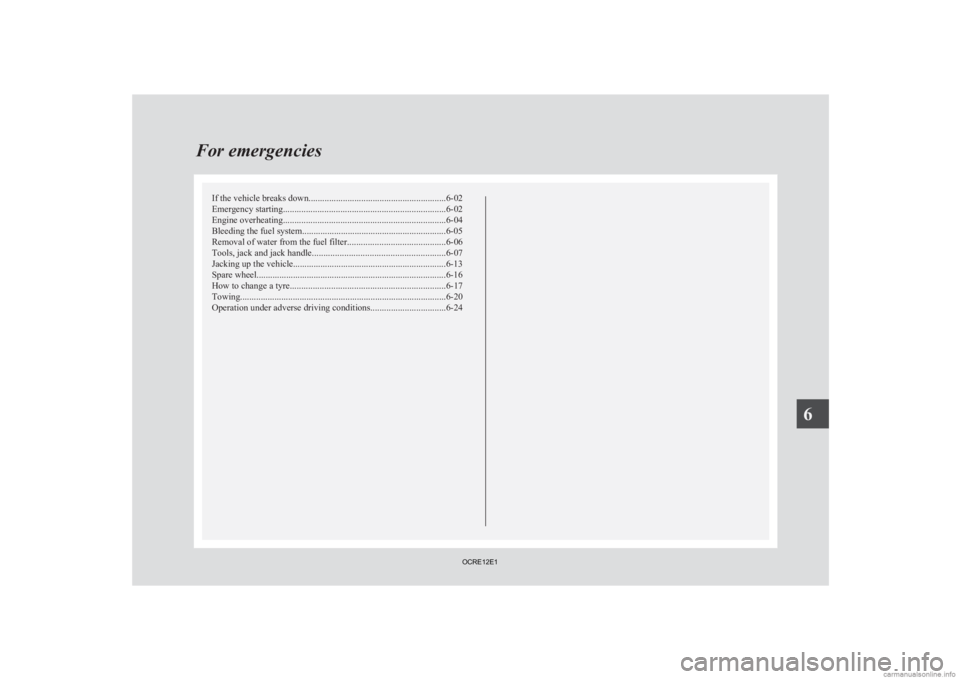
If the vehicle breaks down
............................................................ 6-02
Emergency starting ....................................................................... 6-02
Engine overheating ....................................................................... 6-04
Bleeding the fuel system
...............................................................6-05
Removal of water from the fuel filter ...........................................6-06
Tools, jack and jack handle .......................................................... 6-07
Jacking up the vehicle...................................................................6-13
Spare wheel...................................................................................6-16
How to change a tyre .................................................................... 6-17
Towing.......................................................................................... 6-20
Operation under adverse driving conditions .................................6-24For emergencies
6
OCRE12E1
Page 268 of 370
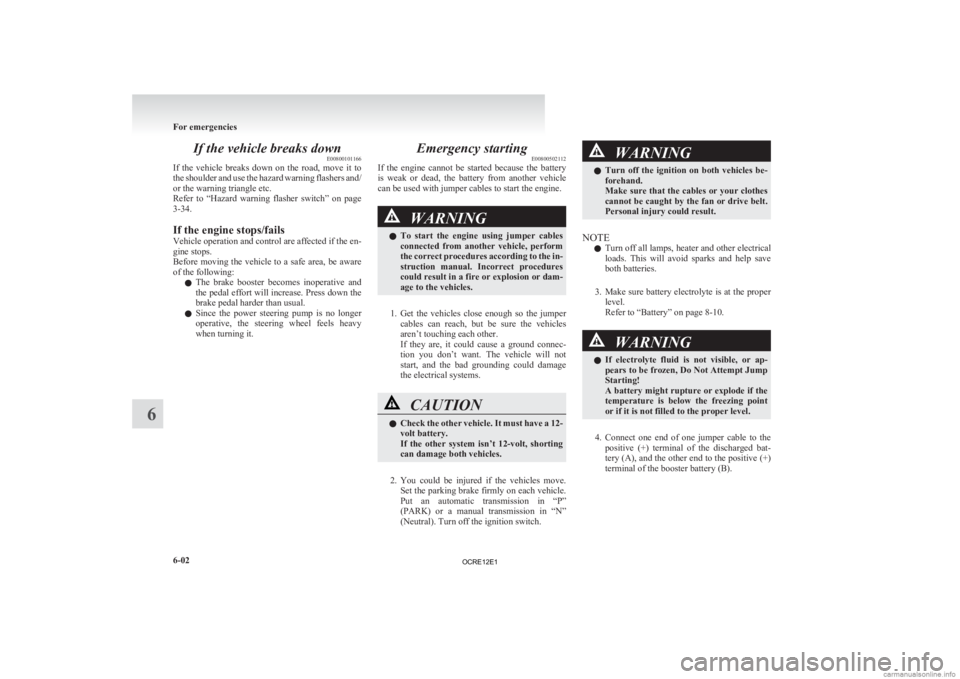
If the vehicle breaks down
E00800101166
If
the vehicle breaks down on the road, move it to
the shoulder and use the hazard warning flashers and/
or the warning triangle etc.
Refer to “Hazard warning flasher switch” on page
3-34.
If the engine stops/fails
Vehicle operation and control are affected if the en-
gine stops.
Before moving the vehicle to a safe area, be aware
of the following:
l The brake booster becomes inoperative and
the pedal effort will increase. Press down the
brake pedal harder than usual.
l Since the power steering pump is no longer
operative, the steering wheel feels heavy
when turning it. Emergency starting
E00800502112
If
the engine cannot be started because the battery
is weak or dead, the battery from another vehicle
can be used with jumper cables to start the engine. WARNING
l To
start the engine using jumper cables
connected from another vehicle, perform
the correct procedures according to the in-
struction manual. Incorrect procedures
could result in a fire or explosion or dam-
age to the vehicles.
1. Get
the vehicles close enough so the jumper cables can reach, but be sure the vehicles
aren’t touching each other.
If they are, it could cause a ground connec-
tion you don’t want. The vehicle will not
start, and the bad grounding could damage
the electrical systems. CAUTION
l
Check
the other vehicle. It must have a 12-
volt battery.
If the other system isn’t 12-volt, shorting
can damage both vehicles.
2. You
could be injured if the vehicles move. Set the parking brake firmly on each vehicle.
Put an automatic transmission in “P”
(PARK) or a manual transmission in “N”
(Neutral). Turn off the ignition switch. WARNING
l Turn
off the ignition on both vehicles be-
forehand.
Make sure that the cables or your clothes
cannot be caught by the fan or drive belt.
Personal injury could result.
NOTE l Turn
off all lamps, heater and other electrical
loads. This will avoid sparks and help save
both batteries.
3. Make sure battery electrolyte is at the proper level.
Refer to “Battery” on page 8-10. WARNING
l If
electrolyte fluid is not visible, or ap-
pears to be frozen, Do Not Attempt Jump
Starting!
A battery might rupture or explode if the
temperature is below the freezing point
or if it is not filled to the proper level.
4. Connect
one end of one jumper cable to the positive (+) terminal of the discharged bat-
tery (A), and the other end to the positive (+)
terminal of the booster battery (B).
For emergencies
6-02
6
OCRE12E1
Page 269 of 370
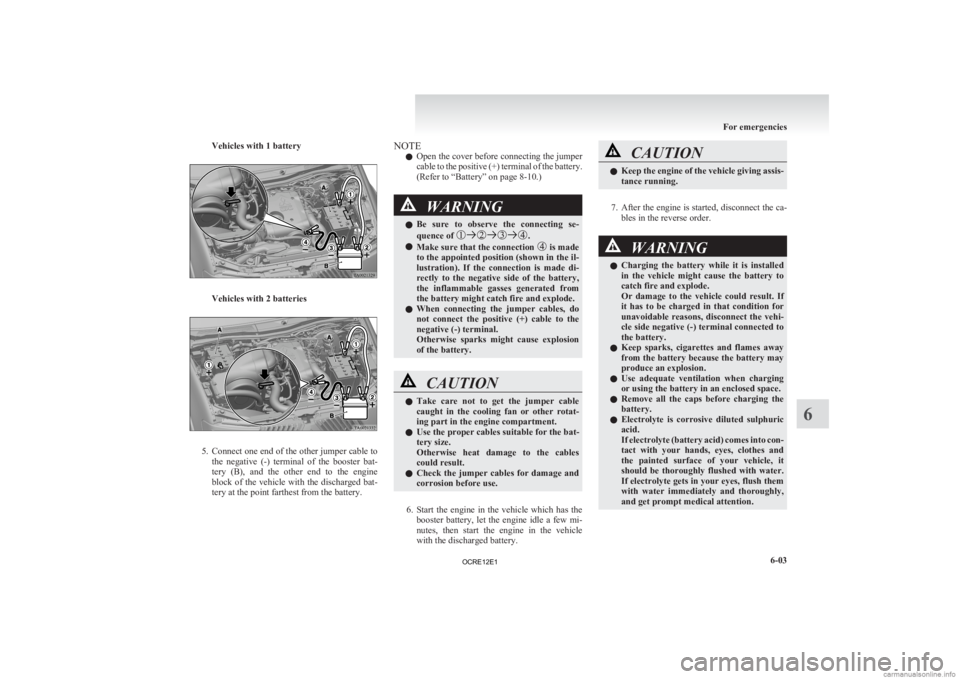
Vehicles with 1 battery
Vehicles with 2 batteries
5. Connect one end of the other jumper cable to
the negative (-) terminal of the booster bat-
tery (B), and the other end to the engine
block of the vehicle with the discharged bat-
tery at the point farthest from the battery. NOTE
l Open
the cover before connecting the jumper
cable to the positive (+) terminal of the battery.
(Refer to “Battery” on page 8-10.) WARNING
l Be
sure to observe the connecting se-
quence of .
l Make sure that the connection is made
to
the appointed position (shown in the il-
lustration). If the connection is made di-
rectly to the negative side of the battery,
the inflammable gasses generated from
the battery might catch fire and explode.
l When connecting the jumper cables, do
not connect the positive (+) cable to the
negative (-) terminal.
Otherwise sparks might cause explosion
of the battery. CAUTION
l
Take
care not to get the jumper cable
caught in the cooling fan or other rotat-
ing part in the engine compartment.
l Use the proper cables suitable for the bat-
tery size.
Otherwise heat damage to the cables
could result.
l Check the jumper cables for damage and
corrosion before use.
6. Start
the engine in the vehicle which has the booster battery, let the engine idle a few mi-
nutes, then start the engine in the vehicle
with the discharged battery. CAUTION
l
Keep
the engine of the vehicle giving assis-
tance running.
7. After
the engine is started, disconnect the ca- bles in the reverse order. WARNING
l Charging
the battery while it is installed
in the vehicle might cause the battery to
catch fire and explode.
Or damage to the vehicle could result. If
it has to be charged in that condition for
unavoidable reasons, disconnect the vehi-
cle side negative (-) terminal connected to
the battery.
l Keep sparks, cigarettes and flames away
from the battery because the battery may
produce an explosion.
l Use adequate ventilation when charging
or using the battery in an enclosed space.
l Remove all the caps before charging the
battery.
l Electrolyte is corrosive diluted sulphuric
acid.
If electrolyte (battery acid) comes into con-
tact with your hands, eyes, clothes and
the painted surface of your vehicle, it
should be thoroughly flushed with water.
If electrolyte gets in your eyes, flush them
with water immediately and thoroughly,
and get prompt medical attention. For emergencies
6-03 6
OCRE12E1
Page 270 of 370
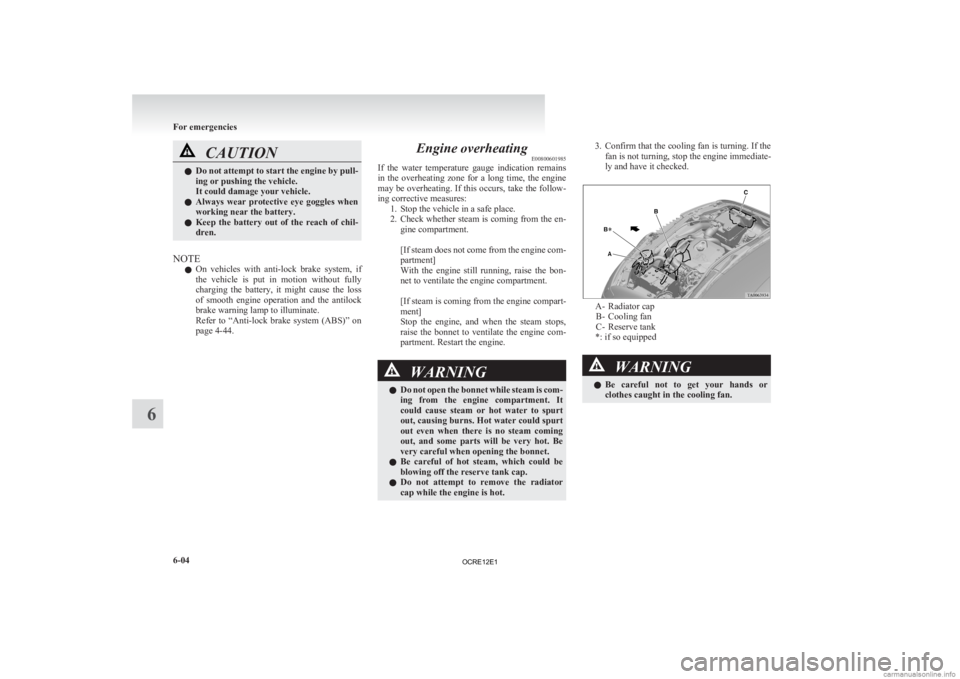
CAUTION
l
Do not attempt to start the engine by pull-
ing or pushing the vehicle.
It could damage your vehicle.
l Always wear protective eye goggles when
working near the battery.
l Keep the battery out of the reach of chil-
dren.
NOTE l On
vehicles with anti-lock brake system, if
the vehicle is put in motion without fully
charging the battery, it might cause the loss
of smooth engine operation and the antilock
brake warning lamp to illuminate.
Refer to “Anti-lock brake system (ABS)” on
page 4-44. Engine overheating
E00800601985
If
the water temperature gauge indication remains
in the overheating zone for a long time, the engine
may be overheating. If this occurs, take the follow-
ing corrective measures: 1. Stop the vehicle in a safe place.
2. Check whether steam is coming from the en-gine compartment.
[If steam does not come from the engine com-
partment]
With the engine still running, raise the bon-
net to ventilate the engine compartment.
[If steam is coming from the engine compart-
ment]
Stop the engine, and when the steam stops,
raise the bonnet to ventilate the engine com-
partment. Restart the engine. WARNING
l Do
not open the bonnet while steam is com-
ing from the engine compartment. It
could cause steam or hot water to spurt
out, causing burns. Hot water could spurt
out even when there is no steam coming
out, and some parts will be very hot. Be
very careful when opening the bonnet.
l Be careful of hot steam, which could be
blowing off the reserve tank cap.
l Do not attempt to remove the radiator
cap while the engine is hot. 3. Confirm
that the cooling fan is turning. If the
fan is not turning, stop the engine immediate-
ly and have it checked. A- Radiator cap
B-
Cooling fan
C- Reserve tank
*: if so equipped WARNING
l Be
careful not to get your hands or
clothes caught in the cooling fan. For emergencies
6-04
6
OCRE12E1